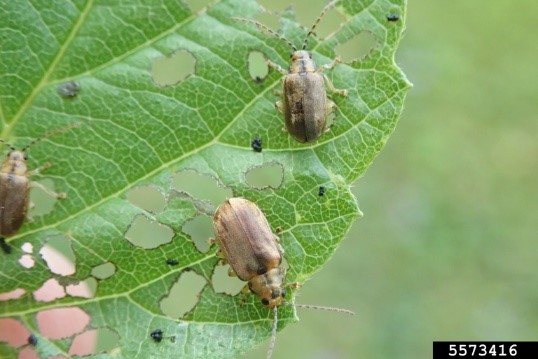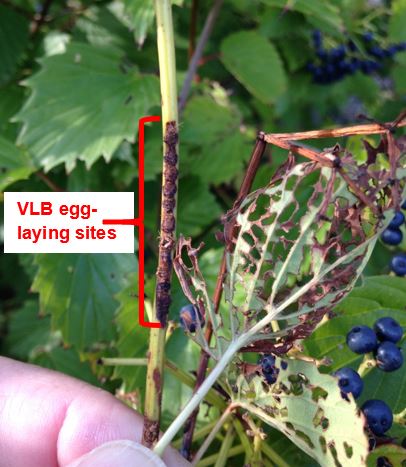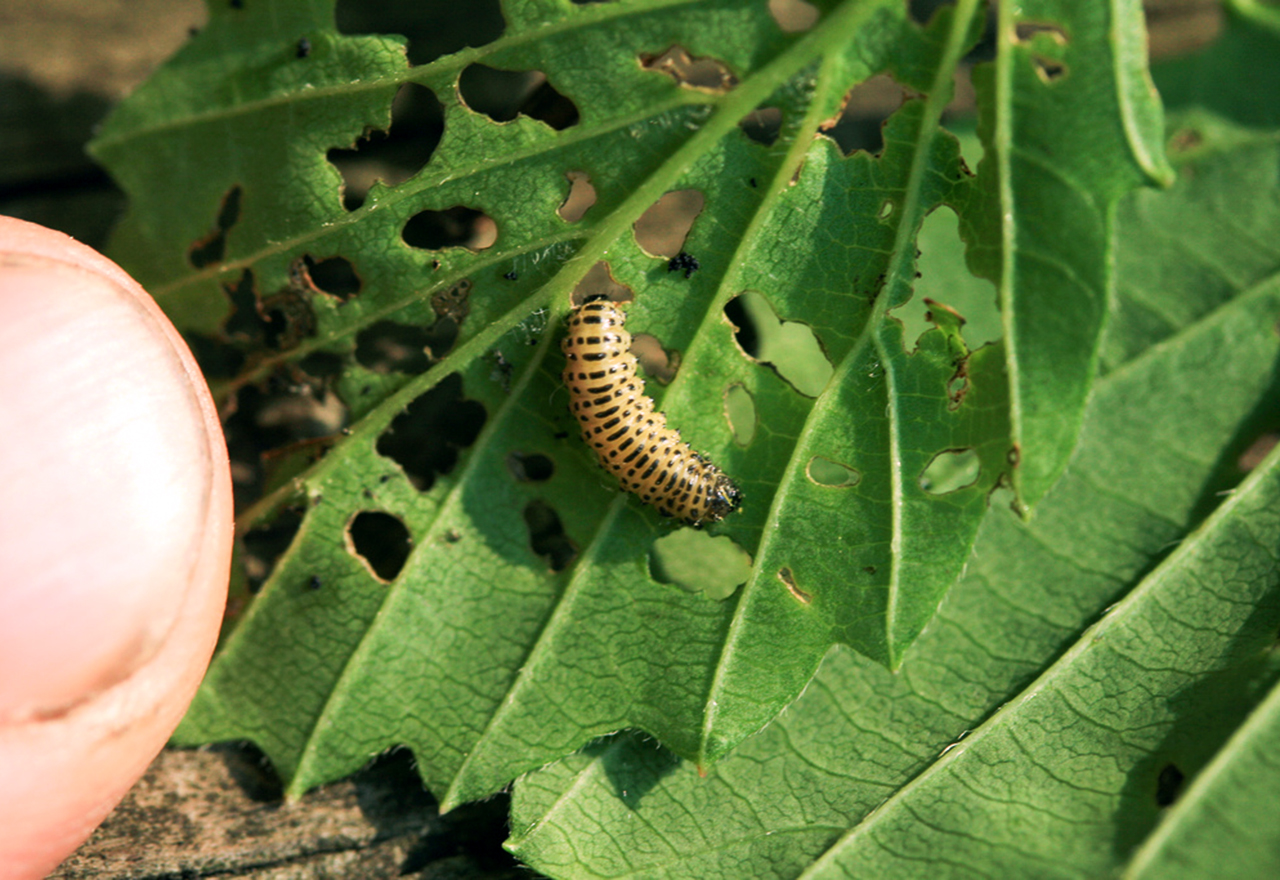Insecticide For Viburnum Leaf Beetle
Viburnum leaf beetle, native to Europe, was first reported in Michigan in 2008. It has now been found in many locations in the southern half of the lower peninsula of Michigan and is expected to spread across the entire state.
Reviewing an article from Weston et al. 2007, one learns that viburnum leaf beetle is an insect species that only feeds on the leaves of shrubs in the genus Viburnum. It seems to find some species and cultivars of viburnum to be “tastier” than others. It is a double threat for its preferred shrub as both the larvae and adult beetles feed on the leaves. The larvae may defoliate the plant at the beginning of the season, then the adult beetles may defoliate the plant during the second half of the growing season. With so much leaf damage throughout the growing season, there is not much time for the plant to recover and build up nutrients for future growth. Consecutive years of defoliation can cause significant dieback and eventually kill plants.
The Cornell University Viburnum leaf beetle website is a very useful resource and provides a timeline of the life stages of this beetle pest, which can help with identification and management. Some of the basic management strategies listed by this website are described below. The Cornell University Department of Horticulture has taken leadership on researching and describing this insect pest in the United States.
Starting in late April, the younger greenish-yellow VLB larvae feed gregariously on the underside of tender, newly expanding viburnum leaves, skeletonizing the foliage. Damage usually starts on lower leaves with only the midribs and major veins left intact.
As the larvae mature, they grow to about one-third of an inch long, darken and develop a series of dark spots. These larger larvae are more likely to be found feeding on the tops of leaves. Adults will start feeding on the leaves in July and are active until frost.

What to do about viburnum leaf beetle
Choose resistant varieties and scout susceptible ones. Start by knowing the host. As mentioned, certain species and cultivars of viburnum are more susceptible to VLB damage than others. Cornell University has been maintaining a list of the most resistant and susceptible varieties to VLB damage, most recently updated in March 2018. The extremes are mentioned below. If you are going to choose a new viburnum bush to plant in your landscape, choose one of the most resistant varieties. If you already have one of the more susceptible varieties in your landscape, pay special attention to it and keep an eye out for injury caused by this pest.
Preferred hosts for VLB, i.e. shrub varieties most susceptible to infestations:
- Viburnum dentatum complex (arrowwood viburnums)
- V. nudum (possum-haw, smooth witherod viburnum)
- V. opulus (European cranberrybush viburnum)
- V. opulus var. americana (formerly V. trilobum) (American cranberrybush viburnum)
- V. propinquum* (Chinese viburnum, Taiwanese viburnum)
- V. rafinesquianum (Rafinesque viburnum)
Resistant hosts:
- V. bodnantense (dawn viburnum)
- V. carlesii (Koreanspice viburnum)
- V. davidii* (David viburnum)
- V. x juddii (Judd viburnum)
- V. plicatum (doublefile viburnum)
- V. plicatum var. tomentosum (doublefile viburnum)
- V. rhytidophyllum (leatherleaf viburnum)
- V. setigerum (tea viburnum)
- V. sieboldii (Siebold viburnum)
*Based on observations at the Van Dusen Botanical Garden, Vancouver, B.C. by Carolyn Jones
Prune out twigs with egg-laying sites. Removing the egg-laden twigs between early October and mid-April can be very successful in reducing the VLB population in your landscape.

Support beneficial predatory insects. Lady beetles, lacewings and spined soldier bugs, in different stages, eat viburnum leaf beetle larvae and adults. You can support these predators’ populations with diverse landscape plantings, for habitat. Also know that certain types of pesticides (e.g. broad-spectrum insecticides) are more detrimental for these beneficial insects than others.
Insecticide choices. Insecticidal soaps, spinosad, or chlorantraniliprole (Acelepryn) can help control the VLB pest with reduced harm to beneficial insects. These pesticides work best when applied to larvae early in the life cycle, likely in late April or early May. Spinosad and chlorantraniliprole also control adult viburnum leaf beetles.
Products containing carbaryl (Sevin) as the active ingredient or one of the pyrethroid insecticides (cyfluthrin, permethrin, resmethrin) are highly effective as foliar sprays, though also more toxic to other insects. Honey bees and other pollinators can be protected by spraying before flower buds open or by waiting until the petals fall. Soil-applied systemic products that contain imidacloprid are also effective but should also be applied after the flowers are gone to protect bees. Based on research by Cornell University, mentioned in a 2007 article by Paul Weston and others, a soil drench with an imidacloprid-based product can provide VLB control for at least two years.
Only spray infested viburnum plants and try to avoid drift onto other plants to preserve pollinators and other beneficial insects in the yard and garden.
Insecticide For Viburnum Leaf Beetle
The Viburnum leaf beetle is a common pest of viburnums. It can damage plants in this way:
-It eats the leaves of the plant. This can cause the leaves to turn brown, which can reduce the plant’s ability to photosynthesize and produce energy for itself. If enough leaves are damaged, the plant will die.
-It lays its eggs on the underside of the leaves and then covers them with a protective layer of feces called frass. The larvae hatch from these eggs and eat their way out of the leaf tissue. They then pupate, emerging as adults ready to mate and start laying their own eggs on new plants.
The adult beetles are small, oval-shaped insects with a shiny black head and thorax (the front part of an insect’s body). Their bodies are covered in tiny hairs that look like scales or bristles when viewed under a microscope or magnifying glass; these hairs help protect them from predators while they’re feeding on leaves or laying eggs in clusters on stems or branches near ground level (where they won’t be seen by birds). The larvae are white or yellowish in color with brown heads; they feed on leaves until they reach maturity before pupating into adults
List Of Insecticide For Viburnum Leaf Beetle
- INSECT KILLER: Kills Aphids, Caterpillars, Whiteflies, Japanese Beetles, and more on contact
- 30 DAY PROTECTION: Protects against listed insects for up to 30 days
- USE ON: Roses, flowers, plants, and even houseplants
- RAINPROOF PROTECTION: Rainproof within 1 hour of application
- COVERAGE AREA: Treats up to 34 plants
- RESTRICTIONS: Restricted in CT, MD, & VT. Not for sale, sale into, distribution, and or use in Nassau, Suffolk, Kings and Queens counties of NY
Additional Info :
| Color | Ready-to-Use |
| Item Dimensions | |
| Height | 11.25 Inches |
| Width | 2.19 Inches |
| Length | 5 Inches |
| Weight | 0.00024 Pounds |
Additional Info :
| Item Dimensions | |
| Height | 10.1 Inches |
| Width | 1.9 Inches |
| Length | 8 Inches |
| Weight | 5.1257475915 Pounds |
| Release Date | 2017-12-05T00:00:01Z |
- INSECT KILLER: Kills 100+ insects including Aphids, Caterpillars, Whiteflies, Japanese Beetles, and more
- KILLS ON CONTACT: Kills listed insects on contact
- 14 DAY PROTECTION: Protects against listed insects for up to 14 days
- USE ON: Roses, flowers, plants, and even vegetable gardens
Additional Info :
| Color | White |
| Item Dimensions | |
| Height | 1 Inches |
| Width | 1 Inches |
| Length | 1 Inches |
| Release Date | 2021-11-11T00:00:01Z |
- Safe
- Extra Concentrated for Long-Lasting Protection
- Natural Ingredients Proven Effective in the Real World
- Large 16oz Bottle
- Powerful Essential Oil
Additional Info :
| Item Dimensions | |
| Weight | 1 Pounds |
- Ortho Home Defense Insect Killer for Indoor & Perimeter2 with Comfort Wand kills ants, cockroaches, spiders, fleas, ticks and other listed bugs; the formula is odor free, won’t stain, and keeps listed bugs out
- KILLS BUGS INSIDE: Kills those annoying home-invading insects, including ants, cockroaches, spiders, fleas, ticks, scorpions, beetles, silverfish, centipedes and millipedes
- KEEPS BUGS OUTSIDE: Creates a bug barrier that will kill bugs you have and prevents new bugs for up to 12 months (applies to ants, roaches and spiders indoors on non-porous surfaces)
- NO STAINING OR STINK: This spray can be used indoors and out, leaves no residue, and has no odor; people and pets may re-enter treated areas after spray has dried
- WAND MAKES APPLICATION EASY: The Comfort Wand eliminates hand fatigue, and there’s no pumping required, making it easy to spray along your home’s perimeter–indoors and outside
Additional Info :
| Color | White |
| Item Dimensions | |
| Height | 4.88 Inches |
| Width | 12 Inches |
| Length | 8.95 Inches |
| Weight | 0.73 Pounds |





